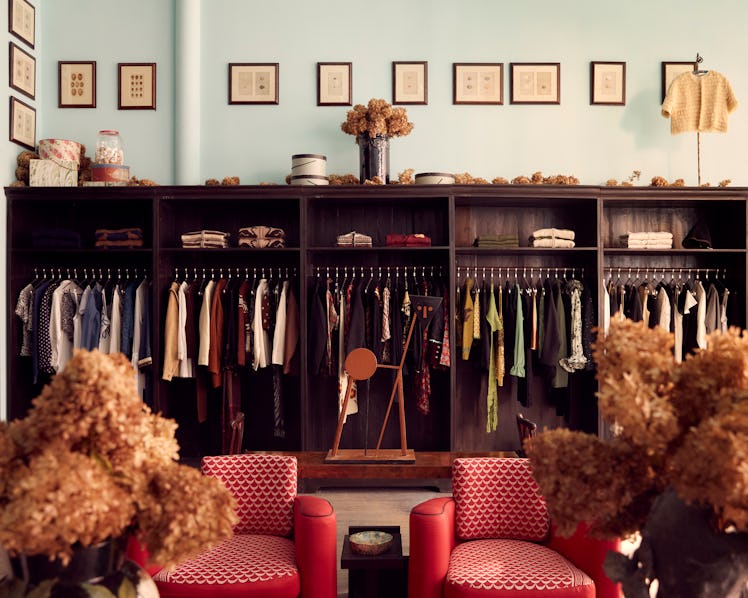Bode’s Vision of Femininity Finds a Home

On a quiet, unassuming block in New York’s Tribeca neighborhood, tucked between an exercise studio and a neighborhood restaurant, gold lettering on a set of arched windows spells out offerings that suggest a bygone era: Cut-and-Sew, Recreation, Underpinnings, Handbags, and Gowns. Silk shibori curtains obscure what’s inside, sure to further pique any passerby’s sense of curiosity. But rather than forgotten wares from another century, what’s behind them is entirely contemporary.
The exterior of the Bode womenswear shop, on Worth Street, maintains a sense of privacy and mystery.
Bode, the clothing line founded in 2016 by Emily Adams Bode Aujla, has transformed the menswear landscape by making the historical feel not just relevant, but urgent and exciting. Over the past seven years, we’ve seen heartthrob actors wearing jackets fashioned from old quilts, and star athletes wearing shirts cut from antique lace tablecloths. Once associated with women’s work and domesticity, these crafts have come to define the new masculinity.
Bode has always had a passionate base of female fans, catering to them with smaller size runs and custom tailoring, but until earlier this year, they didn’t carry anything that was made specifically for womens’ bodies. “Menswear is my passion, and I wanted to make sure I understood that business and that we could grow and scale before we started even talking about other categories,” Bode Aujla said. “Womenswear needed to have a different philosophy, and to reflect a different observation about our culture.”
Debuted on the runway in Paris in January, a collection dubbed The Crane Estate featured gauzy golden gowns, sequined sheaths, cropped fringed jackets, and jeweled crowns—all striding confidently in a new direction, while still very much rooted in the brand’s signature aesthetic. Those pieces (and much more) are now available in their own dedicated space, tucked behind those silk curtains on Worth Street.
Vintage art and furniture enliven a corner.
Upholstered stools by Green River Project flank an antique table at the entrance.
The French blue fabric on a Green River Project sofa contrasts with walls inspired by a Parisian photography shop.
A piece from the Crane Estate collection hangs in a dressing room.
On a Tuesday night in November, friends and fans of the brand (including Dakota Johnson, who recently wore a chiffon Bode gown to the Toronto International Film Festival) gathered in the shop to peruse the racks and take in the latest extension of the Bode universe—which until now has been concentrated in the Lower East Side, where their menswear shop, tailor shop, and private showroom are located. In the years since they opened their first location on Hester Street, that enclave has been transformed into something of an indie retail corridor.
The foray into Tribeca feels like a declaration that the brand goes beyond the scene it helped create: “It’s really important for us to be in neighborhoods where people do not just their shopping, but their living—buying groceries, picking up dry cleaning, going to work out,” Bode Aujla said. “I love the idea of people re-discovering their own surroundings while walking around.”
Dried hydrangeas from the designer’s yard in Connecticut stand guard behind a Green River Project settee.
The interior of the womenswear store, like all of the brand’s spaces, was designed by Green River Project, the firm founded by Bode Aujla’s husband, Aaron Aujla, and Benjamin Bloomstein. And although it feels very much part of the same visual language, it’s also a departure: “It would have been easy for us to open another store that felt aesthetically like Hester Street,” Bode Aujla said. “This needed to be a different vision for women. It’s very feminine, it’s elegant. It’s kind of like an American vision of French interiors.”
Like the first collection, parts of the space were inspired by the women in Emily’s family, in particular her mother and aunts, whose tastes ranged from low-key and bohemian to glamorously European. At the center of the room, red silk club chairs play well with a leopard print velvet settee and stools. On opposite sides, open armoires made from reclaimed Burmese teak, originally used in government offices in Calcutta, house the collection. The walls, painted in a pale, arsenic-adjacent greenish-blue, are inspired by a similar hue Emily and Aaron once encountered at a photography shop in Paris, owned by the grandson of the interior designer Madeleine Castaing. Vintage vases filled with dried hydrangeas cut from the couples’ yard in Connecticut add a personal touch.
“There are so many stories that we wanted to tell,” Aujla said of his design vision. “The facade started a conversation, and that started a chain reaction. I wanted to create a space filled with all of these objects that make you feel like you’re in more than just a store.”